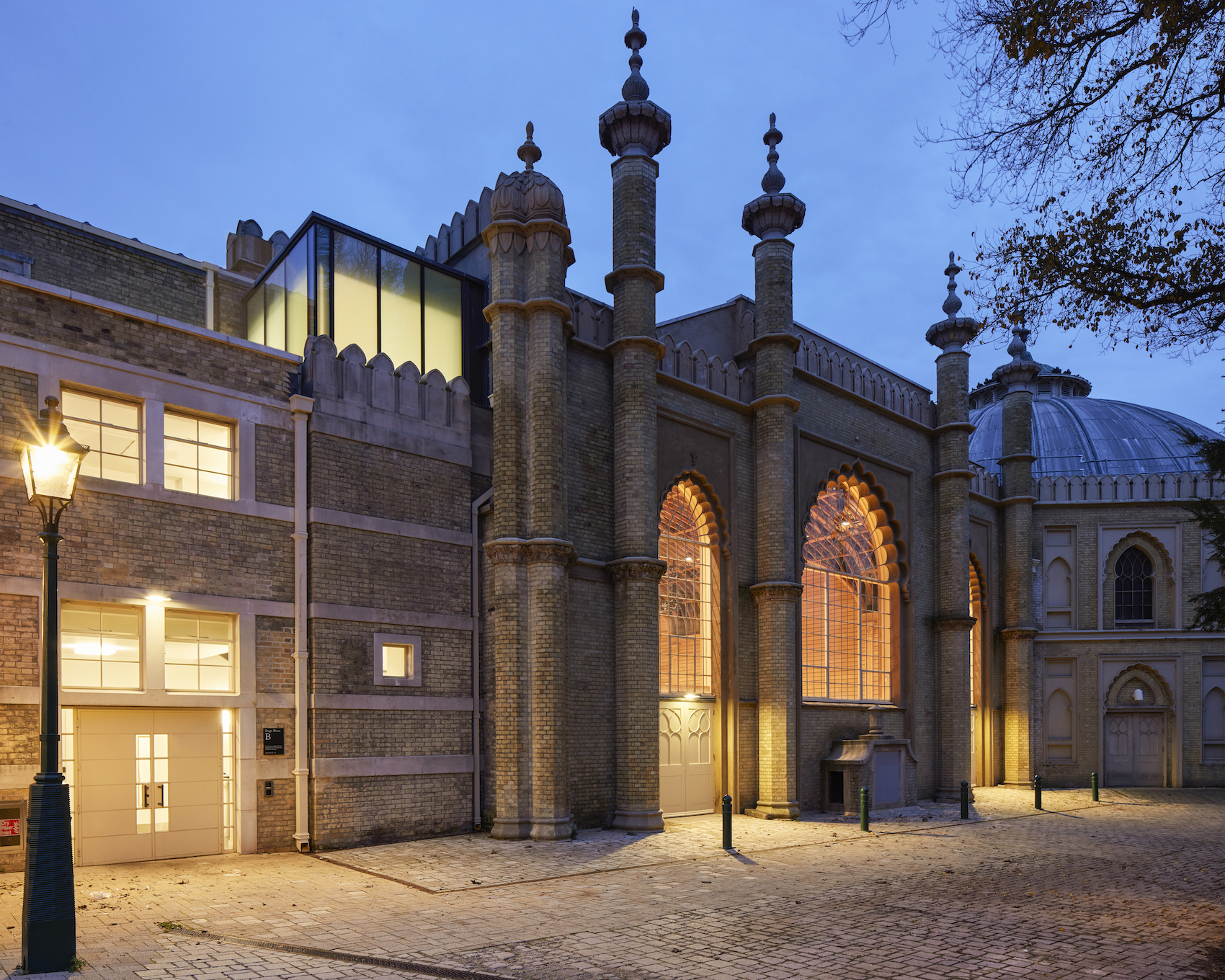Feilden Clegg Bradley Studios has skilfully reworked a major arts venue in Brighton.
Photos
Richard Chivers, Chloe Hashemi, Nick Street, Andy Stagg
Feilden Clegg Bradley Studios has refurbished the Grade I-listed Corn Exchange and Grade II-listed Studio Theatre, which forms part of Brighton Dome, a major arts venue in the heart of the city. The £38m project unites, restores and upgrades four existing buildings: the Corn Exchange, Studio Theatre, 29 New Road, and the Church Street entrance, while a new link building captures a former courtyard space, providing a foyer and public and support facilities.
Essential conservation work to the listed buildings have peeled back existing layers, restoring and revealing hidden spaces to the public. The new foyer, top-lit bar and gallery space, and restaurant opening onto New Road improve the visitor experience, while new toilets and circulation space provide better facilities and accessibility for visitors, performers and artists.
The Corn Exchange’s pioneering column-free timber structure measures 54x18x10 metres and can accommodate 505 seated and 1291 standing people, including performers and staff. “What appealed to us most when we started the project was the Corn Exchange,” explains FCBS’s Peter Clegg. “It was the first of the Regency Buildings in Brighton and as far as we know is still the widest single-span timber-framed building in the country. Seeing the space now – fully restored, with all the layers that had been added over the years stripped out – you can see what an extraordinary building it is.”
Working with theatre experts and skilled craftspeople, the ceilings have been removed to reveal the original timber roof structure, and the original character of the building restored. Windows along the west side have been opened up, and their original decorative timber linings revealed and restored using specialist craft skills and workmanship. Where necessary, the timber linings to the walls and dormer roof arches have been repaired, using some 6500 linear metres of sustainable European oak cladding.
“To some extent we didn’t know what to expect when first investigating the 18-metre structural timber frame,” says Clegg. “Once the layers of paint were removed, we could better understand the condition of the original structure. We were able to find an engineering solution that meant the frame could be repaired and strengthened to make it structurally sound, as well as housing essential production equipment such as the lighting and audio rigs.”
The Corn Exchange can now host a diverse range of uses, from dance and music performances to banqueting, exhibitions, meetings, graduation ceremonies and celebrations. New interventions include sub-floor storage, suspended rigging, a north-end balcony, which conceals a 232-seat retractable bleacher unit, and a ventilation system using heat-exchange technology.
Opening up the west side windows to the Corn Exchange introduces borrowed daylight through the new public foyer and gallery. This also opens up views into the Corn Exchange from the gallery and Studio Theatre foyer, creating a dialogue between the audiences of the different spaces. “Very rarely do you get the ability to see from foyer to auditorium through a giant window,” says Clegg. “The public are welcomed into the double height entrance foyer and offered a glimpse of the drama of the Corn Exchange through the original but now refurbished windows.”
The Studio Theatre is housed in a grade II-listed 1930s, former supper room, that hosts 225 seats for more intimate performances, spoken word and rehearsals. The theatre has been renovated and replanned to improve capacity in a more flexible arrangement, with the addition of side balconies. A new lift and escape stair enable it to have its own accessible foyer space with views through the windows of the Corn Exchange. New dressing rooms and technical infrastructure dramatically improve the usability of the facility. The ground floor of the Studio Theatre Building is occupied by a public restaurant, operating independently of the venues.
A new creative space, called Anita’s Room, can accommodate up to 40 people and is fully equipped with a lighting grid and mixing desk. Supporting works in progress, small-scale performances and events, Anita’s Room will be made available to Brighton Dome associate artists, resident artists, visiting performing artists, community projects, and creative learning organisations. The space is named in memory of Dame Anita Roddick, the activist, entrepreneur, and founder of The Body Shop and was made possible following a generous grant from The Roddick Foundation.
A new foyer and gallery connects the existing buildings, adding key facilities for audiences and performers to unite the venues and improve the experience for all. The public are welcomed in through the top-lit double-height foyer space, which houses a ticket office and the first-floor gallery bar. Stitching together the four existing buildings, the central space gives rare opportunities for views between the venues. The off-white brickwork to the west wall of the Corn Exchange forms an impressive backdrop to the new Gallery bar. New staircases at the north and south of the new-build element complete a public route through gallery, connecting the Corn Exchange and Studio Theatre, as well as Church Street and New Road.
New facilities serve the back-of-house spaces of all three of the venues, and are connected below ground with access routes and shared storage space. Services for the Corn Exchange, Studio Theatre and Anita’s Room, as well as Brighton Dome and Brighton Museum, are centralised. Using a mix of retrofitted existing services and new additions, heat recovery units reduce the heating or cooling required, depending on the time of year. A central energy centre was kept online during the construction phase to maintain the operation of the existing theatre and museum that shared the same services.
Additional Images
Credits
Client
Brighton Dome & Brighton Festival Ltd and Brighton & Hove City Council
Architect
Feilden Clegg Bradley Studios
Theatre consultant
Charcoal Blue
Structural engineer
ARUP
Services engineer
Max Fordham
Quantity surveyor
Jackson Coles
Source: Architecture Today










